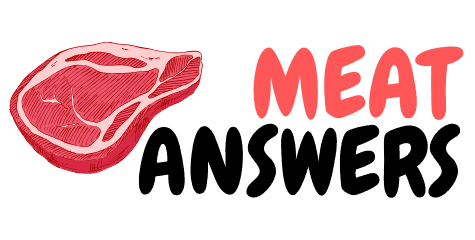For many years as a novice griller, grilling steak was as easy as marinating it, firing up my good ol’ gas grill, and throwing it on the grates.
But it goes way beyond just getting the right marination and cook time right—I’m referring to, and something I overlooked—keeping tabs on the internal temperature of the steak.
One of the biggest reasons you need to pay attention to the internal temperature of the steak you’re grilling is to achieve the perfect doneness such as medium-rare, well-done, etc.

Table of Contents
What is the Internal Temperature of Steak and its Importance?
Grilling steak may seem like a straightforward process, but there’s a certain level of finesses that goes into it to get it right!
There are several variables that come into play when cooking steak, most notably the internal cooking temperature.
The reason why steak internal temperature is important is because this number determines the level of doneness, from rare to well cooked.
Speaking of temperatures, it’s highly important that you first bring the steaks you’re going to cook to room temperature, before putting them on the grill, and here’s why!
You can set the steaks for roughly a half-hour to 45 minutes on your kitchen counter to ensure they are an even temperature throughout, and that they cook evenly, rather than a cold interior and burnt exterior.
Another reason why the internal temperature of steaks is important is because it dictates whether the meat is safe for consumption, where the recommended temperature for a rare cooked beef steak as suggested by the USDA is 120°F.
What Factors Determine the Internal Temperature to Grill Steak on a Gas Grill?
There are several factors that determine the right internal temperature to grill steak on a gas grill, most notably the type of steak, thickness of the steak, and of course, the temperature of your grill.
With regards to the temperature of your grill, there are three different types of thermal energy that come into play while your steak cooks on the grill.
Radiation – burning charcoal in your grill produces heat up to 2,000°F (1093°C) deep down in the charcoal, but generally emits roughly around 650°F (343°C) at the grill’s surface itself.
Conduction – the metal grill grates heat up to approximately 400°F (204°C), and are in direct contact with the steaks, as they are placed on them, resulting in searing of the meat—a process known as conduction.
Convection – when the grill and steak heat up, the air that’s circulating in the grill also heats up, especially when the lid is closed. Convection temperature heats up to several hundred degrees similar to a convection oven.
It’s worth mentioning that all of the aforementioned processes work on the exterior of the steak.
Don’t forget that steak contains water—a ratio of 75 percent water, 20 percent protein, and fat, carbohydrates and minerals accounting for the remaining 5 percent.
These ratios may vary depending on the cut of steak, so it does take a certain level of skill to get the results you want.
You should also consider the rising temperatures at the center of the steak when the steak is removed from the grill.
What Temperature to Grill Steak on a Gas Grill?
1. Based on Steak thickness/size
I generally cook all sizes of steaks, starting from 1 1/2-inch-thick porterhouse or thin flank steaks, but what really dictates when they’re done is the internal temperature. The internal temperature remains the same for all sizes of steaks.
2. Based on Type of Steak
Ribeye steaks are my all-time favorite, but apart from that do prefer tenderloin and porterhouse steaks.
Many leading websites claim that the internal temperature of steaks depends on their type, but this is far from true. But the fact is that all types of steaks experience their doneness level at the same temperatures.
However, what’s worth mentioning is the internal temperatures do change based on the type of meat you are cooking, as indicated in the table below (info referenced from FoodSafety.gov).
3. Based on Level of doneness of steak
The internal temperature does indeed change depending on the doneness of the steak.

How to Measure Internal Temperature?
The best and accurate way to measure internal temperature is with a meat thermometer.
A cooking or meat thermometer should be in your kitchen arsenal, because it is a versatile device that can be used to accurately determine the internal temperature of cooked poultry, meat, seafood, baked items, to ensure they are safe for consumption temperature.
1. Tranmix Wireless Meat Thermometer
The Tranmix meat thermometer is in a league of its own, mostly due to its wireless capabilities that allow you to monitor the temperature of your steaks and other meat and from any appliance from a whopping 326 feet away.
The probes included with this package are made from food-grade stainless steel that can withstand up to 716-degrees F.
But that’s not all, the Tranmix wireless meat thermometer features a responsive sensor located in the tip of each probe that renders highly accurate temperature in less than three seconds.
Using the Tranmix meat thermometer is a joy with its onsite eight preset meat types, five preprogrammed doneness levels, and a large LCD screen.
2. ThermoPro TP25 Wireless Meat Thermometer
The ThermoPro TP25 also features a wireless design as the Tranmix device but works a bit differently by delivering meat temperatures via Bluetooth right on your mobile device located 500 feet away from the cooking appliance.
It comes with four color-coated probes, complete with probe winders to monitor different types of food items without any confusion.
The app is a no-brainer to use and boasts a simplistic design, from where you can configure your desired food temperature, and even the high and low temperatures for your grill.
It used a patented algorithm and even a handy pre-temperature alarm that alerts you when the temperature is 5/10/15 minutes away from your target temperature.




